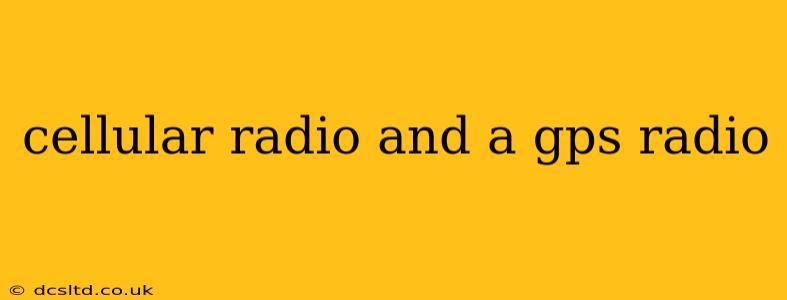Cellular radios and GPS radios, while both utilizing radio waves for communication, operate under vastly different principles and serve distinct purposes. Understanding their key distinctions is crucial for anyone working with wireless technologies, from engineers to everyday consumers. This article will explore the fundamental differences between these two technologies, addressing common questions and clarifying misconceptions.
What is a Cellular Radio?
A cellular radio, more commonly known as a cellular modem or cellular connection, is a device that enables communication over a cellular network. This network is a geographically distributed system of base stations (cell towers) that provides wireless coverage for mobile devices like smartphones, tablets, and IoT devices. Cellular radios use various technologies, including GSM, CDMA, LTE, and 5G, to transmit voice, data, and multimedia content. Their primary function is to connect devices to the internet and enable communication between users. The quality of the connection depends heavily on the strength of the signal received from the nearest cell tower.
What is a GPS Radio?
A GPS radio, also known as a GPS receiver, is a device that receives signals from GPS satellites orbiting the Earth. These satellites transmit radio signals containing precise timing information. By comparing signals from multiple satellites, a GPS receiver can calculate its location (latitude, longitude, and altitude) with a high degree of accuracy. GPS radios don't communicate with other devices in the way cellular radios do; instead, they passively receive one-way signals from the satellites. Their primary function is to determine position and time.
What are the Key Differences Between Cellular Radio and GPS Radio?
The most significant differences between cellular and GPS radios lie in their purpose, communication method, and data transmission.
-
Purpose: Cellular radios facilitate communication between devices and the internet, while GPS radios determine location and time.
-
Communication Method: Cellular radios use two-way communication, transmitting and receiving data over a network of base stations. GPS radios employ one-way communication, passively receiving signals from satellites.
-
Data Transmission: Cellular radios transmit voice, data, and multimedia, while GPS radios transmit only positional and timing information.
-
Frequency Bands: Cellular radios operate on a wide range of frequencies allocated for cellular communication, while GPS operates on specific L-band frequencies reserved for GPS signals.
-
Infrastructure Dependence: Cellular radios rely on a complex network of base stations, while GPS radios primarily rely on the constellation of GPS satellites.
What is the difference between the signal strength of cellular and GPS radios?
Cellular signal strength is highly variable depending on factors like proximity to a cell tower, terrain, and atmospheric conditions. A weak cellular signal can result in slow data speeds or dropped calls. GPS signal strength is also affected by atmospheric conditions (ionospheric and tropospheric delays) and obstacles like buildings and foliage. However, unlike cellular, the signal is generally weaker and only needs to be strong enough to be detected, not to transmit a return signal. A GPS receiver might still provide a position fix even with a weak signal, although accuracy might be reduced.
How do cellular and GPS technologies work together?
While fundamentally different, cellular and GPS technologies are often integrated in devices. For example, location-based services in smartphones use both technologies: GPS provides a precise initial location fix, while cellular triangulation helps refine the location and provide updates even when GPS signals are unavailable or weak (e.g., indoors). Many navigation systems rely on this combined approach for optimal performance.
Can GPS work without a cellular connection?
Yes, GPS technology works independently of a cellular connection. GPS receivers only need a clear view of the sky to receive signals from the satellites. However, cellular data can improve the accuracy and functionality of GPS-based applications, such as providing real-time traffic updates for navigation.
What are some applications of Cellular and GPS Radios?
Cellular Radio Applications: Smartphones, tablets, laptops (with cellular modems), IoT devices, and M2M communication.
GPS Radio Applications: Navigation systems (automotive, aviation, marine), tracking devices (fleet management, asset tracking), surveying and mapping, precision agriculture, and time synchronization.
This detailed comparison clarifies the distinct functionalities of cellular and GPS radios, showcasing their individual strengths and the synergistic potential when combined in various applications. The future likely holds even more integrated uses of these technologies as both continue to evolve and improve.
